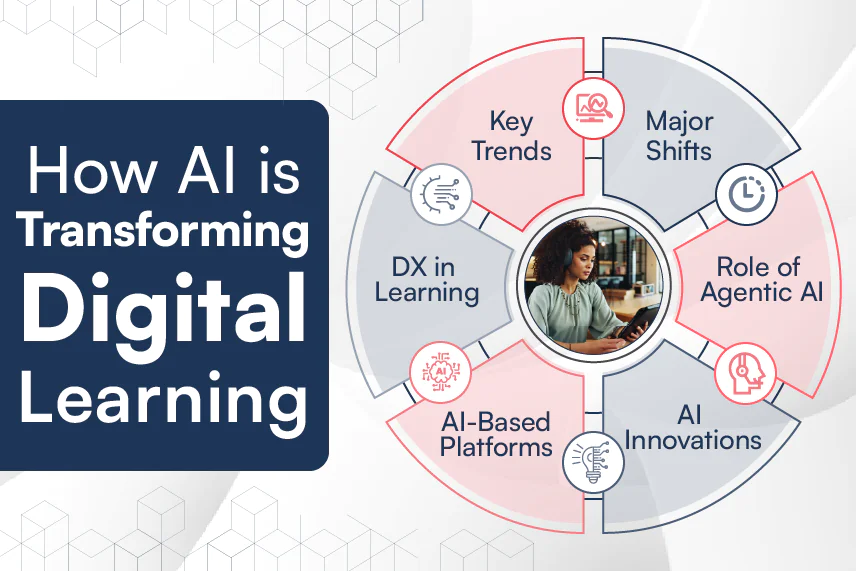
Imagine a learning journey with tailored assistance at every step. AI virtual teaching assistants or AI virtual tutors can make this a reality. These digital tools have the potential to transform learning and instruction like never before.
According to Campfire AI, 57% of students found an AI virtual teaching assistant useful in answering questions. This statistic clearly underscores the growing acceptance and effectiveness of AI-powered solutions in enhancing learner experiences.
This blog post will give you detailed insights into the significance of an AI virtual teaching assistant. You’ll learn how to successfully build an AI virtual teaching assistant. You’ll also explore the most critical advantages of this transformative tool to revolutionize traditional teaching methodologies and optimize learning outcomes. Let’s begin!
AI Virtual Teaching Assistants: Need of the Hour
As modern educational systems strive to cater to the diverse needs and preferences of learners, educators may find themselves overwhelmed by the effort required to personalize learning and instruction for learners. On the other hand, learners may experience burnout as they navigate the pressure to excel in an education system that emphasizes personalized learning experiences.
“According to Harvard Business Review, 75% of enrolled business students struggle with a form of burnout. Another report by the American Educational Research Association states that 74% of teachers had to take up extra duties to cover the staff shortages and 80% of teachers had to do more work than their expected roles and responsibilities due to unfilled job vacancies.”
AI virtual teaching assistants are an indispensable solution to alleviate this burden. They can streamline excessive administrative tasks, accelerate the grading mechanism, and provide personalized learning and instruction. They can offer dedicated learning support and assistance to the students, complementing educators to focus on more complex aspects of teaching while mitigating academic burnout.
For example, these assistants can help educators offer tailored study schedules, recommend supplemental resources based on individual learning styles, and even provide real-time feedback on assignments. They can offer continuous support and adapt to the unique educational needs to empower educators to automate certain tasks, manage workload, and personalize learning and instruction.
Recently, Harbinger Group conducted a Power Hour on ‘Leveraging AI-Enabled Virtual Teaching Assistant to Enhance the Learner Experience.’ The engaging roundtable session was hosted by Rahul Singh, Senior Director – EdTech, Harbinger Group and featured expert panelists: Paul Truax, Co-Founder, Cognify Learning Company and Dr. Kim William Gordon, EdTech Research Scientist, EdTech Research Labs.
The informative session provides actionable insights from these EdTech experts on how AI-based virtual teaching assistants can be designed, customized, deployed, and integrated as per your specific business needs.
AI Virtual Teaching Assistants: 6 Benefits to Maximize Instruction and Learning
There are various ways in which educators can leverage the capabilities of AI virtual tutors to optimize their teaching methodologies and create a lasting impact throughout the learning journey. Here are some of the most significant advantages to consider.
1. Automation of Administrative Tasks
AI virtual teaching assistants can automate routine administrative tasks, such as grading assignments, managing schedules, tracking attendance, and sending important reminders. By automating these tasks, educators can devote more time to developing instructional content and providing personalized learning support.
AI virtual teaching assistants reduce the likelihood of human error in administrative processes, leading to greater efficiency and accuracy in teaching. They can help educators foster meaningful interactions with learners, ultimately enhancing the overall teaching and learning experiences.
2. Data-Driven Insights for Instructional Improvements
AI virtual tutors facilitate differentiated instruction by offering learner-centric pathways and resources to meet the diverse needs of learners. As such, educators can customize instructional materials and assignments based on the interests, learning styles, and proficiency levels of learners.
By analyzing large volumes of data on learner performance and engagement, AI virtual tutors generate actionable insights for educators to enhance their instructional strategies. These insights enable educators to identify areas for improvement, track learner progress, and refine their teaching methods accordingly.
3. Accessibility and Inclusivity in Teaching

AI virtual teaching assistants can help educators promote inclusivity and accessibility in education. They can enable educators to accommodate diverse learning styles, language proficiencies, and accessibility requirements, ensuring that all learners have equitable access to education resources and support.
AI virtual teaching assistants can integrate the teaching approach with features like text-to-speech functionality, closed captioning, and screen reader compatibility. This can help educators enhance the availability of educational content for all, including learners with disabilities.
4. Support for Language Translation and Localization
AI virtual tutors can help educators with language translation and localization of educational content. They can enable educators to deliver instruction in multiple languages and cater to diverse learner populations. These tutors can translate instructional materials and communicate with students in their preferred language.
5. Scalability in Educational Content Creation and Delivery
AI virtual teaching assistants signify the crucial application of Generative AI in teaching. They can help educators maximize the utilization of educational content by supporting large learner populations without compromising the quality of instruction. Educators get the privilege to create and deliver educational content at scale.
AI virtual teaching assistants can complement the competencies of educators by automating and streamlining the following:
- Development of educational content including virtual sessions, assignments, interactive exercises, and multimedia resources.
- Generation of course plan ideas, tailored approaches, and other learning resources.
- AI-based evaluation strategies, assessments, quizzes, and questions.
- Creation of rubrics and review frameworks with clear criteria.
6. Personalization in Teaching Support
AI virtual tutors empower educators to deliver personalized learning and instruction support, tailored to each learner’s unique learning profile and progress. By leveraging machine learning algorithms and adaptive technologies, these tutors can dynamically adjust educational content, pace, and feedback based on individual preferences.
AI virtual tutors can enable educators to create adaptive learning pathways, gather real-time performance analytics, and personalize teaching strategies. Educators can identify areas of improvement, provide timely feedback, and enhance learning outcomes.
How to Build AI Virtual Teaching Assistants: 6 Building Blocks to Consider
The successful design and implementation of AI virtual teaching assistants rely heavily on a robust framework of essential building blocks and foundational elements. Let’s understand them in detail to get a better idea.
1. Defining Business Goals
Before developing an AI virtual teaching assistant, it’s crucial to establish clear business objectives. This involves identifying the specific needs and goals the assistant should address, such as improving the teaching strategy, enhancing learning outcomes, or optimizing resource allocation.
Clear business goals provide a roadmap for the design and implementation of the AI virtual teaching assistant, ensuring alignment with business priorities and maximizing its impact.
2. Prioritizing Prompt Engineering
Prompt engineering involves crafting precise and effective prompts or queries that users will interact with to elicit desired responses from the AI virtual teaching assistant.
This process requires careful consideration of language, context, and user intent to ensure that prompts are intuitive, comprehensive, and capable of generating relevant insights or actions from the assistant. Well-engineered prompts are essential for optimizing the user experience and enhancing the utility of the AI virtual teaching assistant.
Learn how to craft the perfect prompt. Unveil the art of prompt engineering with Harbinger’s state-of-the-art OpenAI-based question generator ‘Quillionz’ to generate top-tier quizzes and assessments. Explore GPT-powered question generation with Quillionz.
3. Uploading Detailed Datasets into the AI Model at Scale
Uploading detailed datasets involves gathering comprehensive data spanning various subjects, learning styles, and proficiency levels. By incorporating large and diverse datasets, the AI model gains a deeper understanding of education concepts, learner behaviors, and instructional strategies.
This enables the AI virtual teaching assistant to provide more accurate and personalized support to educators and learners, effectively addressing their needs. Additionally, scaling up data uploading ensures that the assistant remains up-to-date with evolving education content and trends.
4. Leveraging Natural Language Processing

NLP enables AI virtual teaching assistants to understand and respond to human language, facilitating natural interactions between learners and the virtual assistant. This integration allows for the interpretation of diverse queries, the extraction of meaning from text, and the generation of contextually relevant responses.
5. Implementing Adaptive Algorithms
Adaptive algorithms serve as a crucial building block in designing AI virtual teaching assistants. These algorithms analyze individual learner data, including performance metrics and learning preferences, to dynamically adjust content delivery and recommendations.
Adaptive algorithms empower educators to optimize learner engagement, comprehension, and retention, fostering more effective learning outcomes. They enable targeted support for educators, complementing their core areas and competencies.
6. Harnessing Knowledge Graphs and Semantic Analysis
Knowledge graphs and semantic analysis provide the structural framework for organizing and understanding information within AI virtual teaching assistants. By mapping relationships between concepts and entities, these tools enable assistants to navigate complex subject matter, infer meaning from context, and provide accurate responses.
Knowledge graphs and semantic analysis enhance the AI virtual teaching assistant’s ability to facilitate learning by presenting information in a coherent and interconnected manner.
AI Virtual Teaching Assistants: Final Thought
AI virtual teaching assistants are here to revolutionize education, helping educators gain valuable insights into learner interactions, performance, and learning patterns. They will undoubtedly play a pivotal role in delivering interactive and realistic teaching experiences and enhancing learning outcomes.
AI virtual teaching assistants are a considerable solution that can deliver effective learning and instruction. The emergence of multimodal large language models like GPT-4 will make these assistants more accurate, scalable, efficient, and human-like.
If you want to build an AI virtual teaching assistant or explore AI-powered solutions to shape the future of education, reach out to us at contact@harbingergroup.com. Our EdTech experts would be more than happy to help you achieve your desired business goals.






